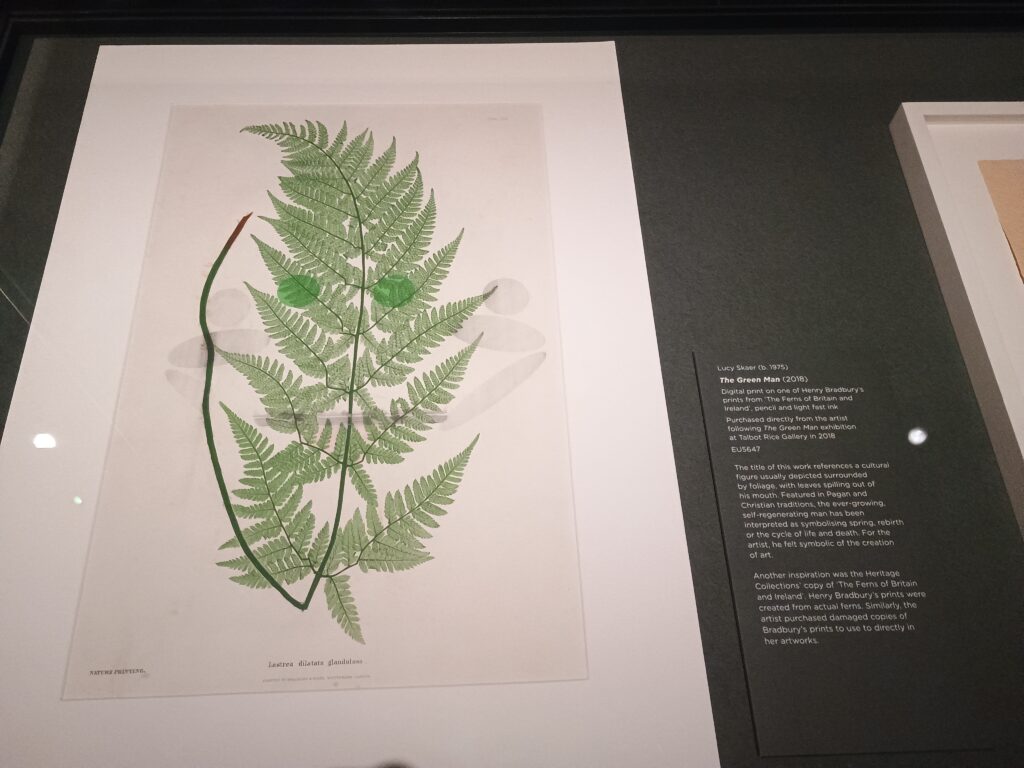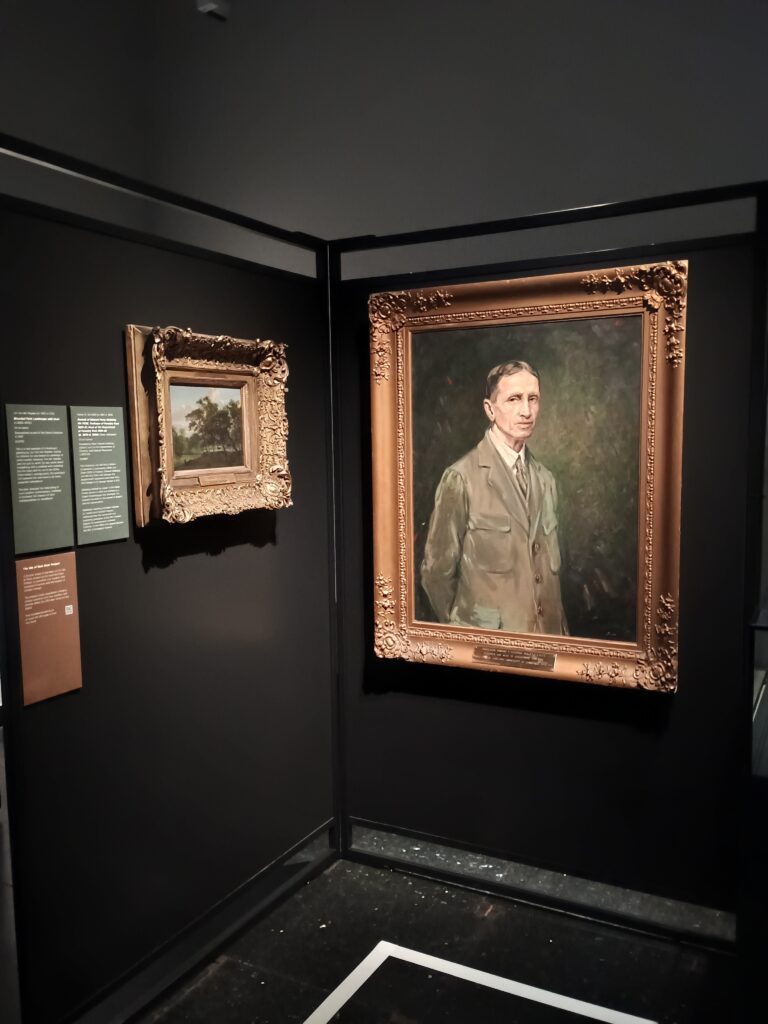Curatorial Analysis: Rooting

Rooting is an exhibition taking place in the University of Edinburgh main library, opening on the 23rd of January 2025. I was able to attend the exhibition opening, listen to opening lectures, and experience the exhibition, despite the interruption of an extreme weather alarm! As a result, my analysis of the exhibition will be informed from exhibition research, and field notes of both the exhibition and verbally communicated information from event speakers.
Delivered in collaboration with the University’s Department for Social Responsibility and Sustainability it aims to highlight the efforts of Edinburgh University to create a more sustainable future. The engagement of these specific disciplines is significant of an ethical curatorial practice. From the perspective of social responsibility event talkers highlighted the importance of acknowledging ecologies of affluence (Demos, 2013) where the individuals who contribute the least to carbon emissions are also those most affected by the repercussions of climate change. This concern progressed into publications, stating that the combination of historic and contemporary artwork asks us to consider ‘environment, ecology, as well as the entangled relationship between economic and colonial legacies and the climate crisis’ (Scottish Contemporary Art Network, 2025). Responding to this there were notable pieces which exposed non-dominant narratives, such as Lucy Skaer’s The Green Man, whose name reflects Pagan traditions of a self-regenerating man as a symbol of life and death. Valentina Lobos Munoz’s Speculative Flag, a translucent fabric suspended in a glass case, reflecting how land, nature, and people are often viewed as resources of commodities within current interpretations of the climate crisis. The gallery label for this piece identifies the use of archive images of human and non-human entities to be a form of ‘stealing’ and using natural resources to expose the social constructs that highlight colonial histories.

Challenging hierarchies is also inherent to the use of archive material throughout the exhibition. Within this exhibition, the use of archive pieces has two main purposes. The first one is more obvious, the presentation of portraiture work. Whilst aesthetically seeming out of place from the ecologically inspired surrounding work, the label identifies these individuals as being associated with the University of Edinburgh. They have a place in the history of conservation, such as the display of Portrait of Edward Percy Stebbing MA FRSE, Professor of Forestry from 1920-51; Head of Department of Forestry from 1910-20 who was involved with advancements of soil conservation. As a result, an individual who may not have received historical regard, or appreciation, has been bought back to public attention, and honoured in this exhibition (Durukan, and Akmehmet, 2020). Secondly, ecological work is brought back to attention. The inclusion and reimagining of historical work such as The Green Man serves to overthrow entrenched historiographies, and challenge the idea that history, as it is presented is objective and comprehensive. This removal from the original context to the contemporary situation within an exhibition focused on climate change, challenges the paradigms and politics when these pieces were made.

This is emblematic of a wider, and historical use of Archive within art exhibitions, used specifically as a tool for institutional critique from the 1970s onwards. The Archive holds a particular power as a vessel of history, and therefore, a force that ‘controls memory’(Durukan, and Akmehmet, 2020), and inherently politicises and critiques original contexts through integration into contemporary exhibitions.
By collaborating with the School of Social Responsibility, Edinburgh University ensures the exhibition is ethically viable in representing a diverse array of viewpoints, whilst engaging in historiographical critique. I think this is a vital element of this exhibition that prevents it from tipping into controversy. An element of the ‘Art, Action, Activism: catalyst for change’ text highlights the work that Edinburgh University has taken in response to student protests. I believe that this is very well stated and does not draw attention from the content of the exhibition. When an organisation’s actions are over emphasised, this publication can serve to reframe the exhibition as a covert way to draw attention to the university’s efforts. While I don’t believe this is a bad thing in itself, the purpose of these public relation initiatives is to earn the institution a better reputation, and therefore a higher engagement rate, and ultimately earn more economic capital. Within the discussions of the Anthropocene, sometimes titled the Capitalocene, an exhibition that purposefully utilises ecology and climate disaster is exploitative of the diverse artists and narratives that it employs. Ultimately, I believe that Rooting effectively situates itself within the university environment without taking advantage of crisis for economic gain.
Action: reflecting on this exhibition I have become more aware of the sensitive space that a politically engaged exhibition resides in. Although I do not think that I am in danger of exploitative controversy, because of the small scale, and no drive for institutional profit, I think it is necessary to examine my own actions, and possibly work with a social responsivity expert. Further, the role of archive is also poignant to my values of representing a variety of viewpoints, and critiquing dominant historical narratives (Durukan, and Akmehmet, 2020, p.143). Though I had not originally anticipated the use of historical work, artists that I have previously identified, such as Charlotte Alexander, explore personal objects as a form of sentimental archiving. This opens the possibility to mediate this artist and a historical archive to commission new work.
Bibliography:
- Durukan, G. and Akmehmet, T. (2020). Uses of the archive in exhibition practices of contemporary art institutions. Archives and Records, pp.131–148.
- Scottish Contemporary Art Network. (2025). Rooting: Ecology, Extraction and Environmental Emergencies in the University’s Art Collection – Scottish Contemporary Art Network. [online] Available at: https://sca-net.org/event/rooting/ [Accessed 24 Feb. 2025].
- The University of Edinburgh. (2024). Current and Forthcoming Exhibitions. [online] Available at: https://library.ed.ac.uk/heritage-collections/museums-and-galleries/exhibitions-whats-on [Accessed 24 Feb. 2025].




Hi, Harry. I really like that you include an Action in each of your posts. It’s a very clear and effective way to plan your next steps and keeps the entire curatorial process well-structured. I also noticed that you’ve divided the exhibition into Past, Present, and Future, which cleverly aligns with the artistic process of reflection, retrospection, and anticipation, making the exhibition’s logic even more coherent. Moreover, instead of following a traditional linear timeline, you chose the sequence Past → Future → Present—a bold and intriguing decision. This contrast can create a strong impact, encouraging visitors to rethink ecological issues. I completely understand your concern—if visitors move too “freely” through the exhibition space, they might not experience the show in the way you intended. One possible solution is to design a “maze-like exhibition route” that subtly guides visitors along a specific path while still allowing some room for exploration. You could incorporate visual and auditory markers at key points, such as colour shifts, lighting cues, and sound prompts, or even use floor projections to naturally lead visitors into the next section. Hope these suggestions are helpful for you!
——Tianyue